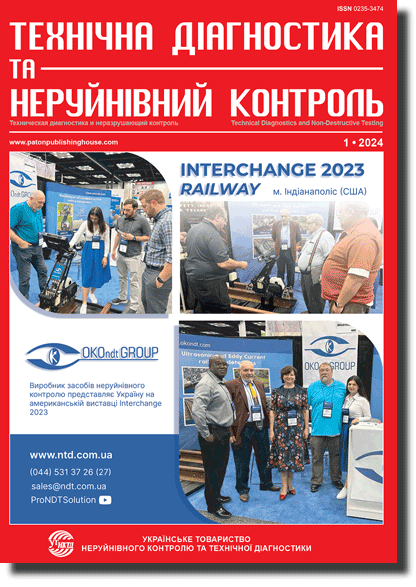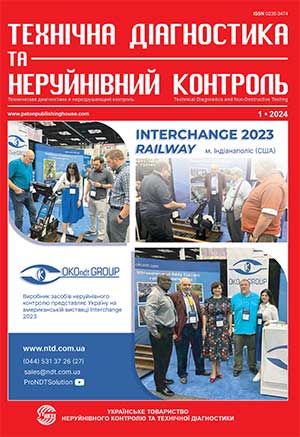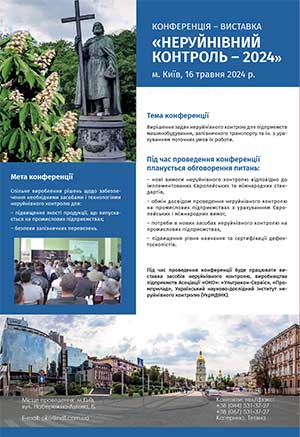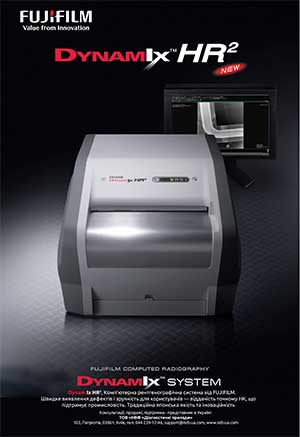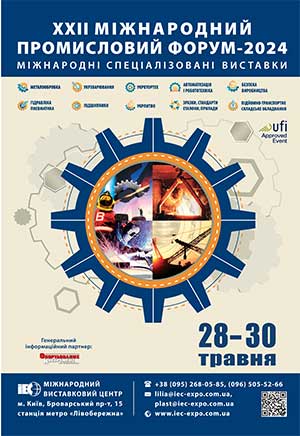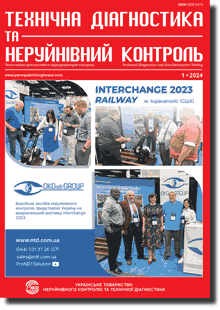
Technical Diagnostics and Non-Destructive Testing #1, 2024, pp. 3-7
2NTUU «Igor Sikorsky Kyiv Polytechnic Institute». 37 Beresteysky Ave., 03056, Kyiv, Ukraine. E-mail: minakovsergey61@gmail.com
3CM DIAGNOSTICS sp. z o.o., ul. Przemiarki 23, lokal 8, Krakow, Poland. E-mail: rsolomak@gmail.com
The general problem of residual magnetization of steel products and a typical case of its formation after cyclic magnetization by an attachable type magnetic transducer in the process of magnetic structural analysis by hysteresis loop parameters determination is highlighted. The importance of reliable assessment of residual magnetization, including for quality control of demagnetization of steel products, is emphasized. The method of determining the residual magnetization and evaluating the quality of the demagnetization procedures of steel products by measuring the residual magnetic field is presented. Residual magnetization of 09G2C type steel specimen after hysteresis loop parameters measuring using a magnetic analyzer of the KRM-Ts-MA type depending on the number of magnetization cycles and its distribution in the area of application of the attachable type magnetic transducer was investigated. It is shown that after multiple magnetization, the level of residual induction in 09G2C type steel products does not exceed 0,75 mT, which allows welding without additional demagnetization operations. The tasks of further research on the influence of residual magnetization of steel products made of different steels on their further use and the formation of additional noise during eddy current testing are formulated. It was shown that the presence of residual magnetization after multiple measurements of hysteresis loop parameters does not affect the accuracy of their repeated measurement, which confirmed the stability of the measurement procedure with a KRM-Ts-MA type magnetic analyzer with respect to the residual magnetization created by it. 16 Ref., 3 Fig.
Keywords: residual magnetization, magnetic structural analysis, attachable magnetic transducer, parameters of the magnetic hysteresis loop, demagnetization
Received: 03.01.2024
Received in revised form: 14.01.2024
Accepted: 12.03.2024
2. Ostash, O.P., Fedirko, V.M. (2007) Fracture mechanics and strength of materials: Refer. Book, Vol. 9:Strength and service life of aircraft materials and structure elements. Lviv, Spolom [in Ukrainian].
3. Kuts, Yu., Protasov, A., Tsapenko, V. et al. (2012) Magnetic non-destructive testing. Kyiv, NTUU KhPI [in Ukrainian].
4. Bezlyudko, G. (2003) Operational control of fatigue condition and residual life of metal structures by nondestructive (coercimetric) method. Tekh. Diagnost. i Nerazrush. Kontrol, 2, 20-26 [in Russian].
5. Lobanov, L.M., Bondarenko, A.Yu., Bondarenko, Yu.K. (2004) Evaluation of welded joints of structures by magnetic (coercimetric) for forecasting individual residual life. Tekh. Diagnost. i Nerazrush. Kontrol, 1, 3-8 [in Russian].
6. Bezlyudko, G.Ya. (2004) Practical evaluation of the condition of welds by measuring the magnetic characteristic - coercive force of the metal. Tekh. Diagnost. i Nerazrush. Kontrol, 1, 20-22 [in Russian].
7. Uchanin, V., Ostash, O., Nardoni, G., Solomakha, R. (2020) Coercive Force Measurements for Structural Health Monitoring, The Fundamentals of Structural Integrity and Failure (Ed. R.M. Wilcox), Nova Science Publishers, New York, USA, 163-192. https://doi.org/10.1016/j.prostr.2019.07.040
8. Rybachuk, V.G., Uchanin, V.M. (2021) Coercive force of two-layer ferromagnetic materials. Vidbir i Obrobka Informatsii, 49(125), 3-8. [in Ukrainian]. https://doi.org/10.15407/vidbir2021.49.003
9. Dobrodeev, P.N. (2014) Study of methods of demagnetization of pipe ends in repair of main pipelines. Elektrotekhnika i Elektromekhanika, 3, 50-54 [in Russian]. https://doi.org/10.20998/2074-272X.2014.3.10
10. https://www.foerstergroup.com/en/usa/products/emag/
11. Rozov, V., Pilyugina, O., Lupikov, V. et al. (2006) Introduction into demagnetization of technical objects. Elektrotekhnika i Elektromekhanika, 4, 55-59 [in Russian].
12. Volokhov, S.A., Dobrodeyev, P.N., Mamin, G.I. (2012) Integrated demagnetization of pipes in electric arc welding. Tekhnichna Elektrodynamika, 4, 19-24 [in Russian].
13. Oxley, P. (2009) Apparatus for magnetization and efficient demagnetization of soft magnetic materials. IEEE Transactions on magnetics, 45(9), 3274-3283. https://doi.org/10.1109/TMAG.2009.2020795
14. Shelikhov, G.S. (2010) Experience in the demagnetization of large objects. Rus. J. of Nondestr. Testing, 46(5), 315-323. https://doi.org/10.1134/S1061830910050013
15. Deng, Z., Yu, Z., Yuan, Z. et al. (2022) Mechanism of Magnetic Permeability Perturbation in Magnetizing-Based Eddy Current Nondestructive Testing. Sensors, 22, 2503. https://doi.org/10.3390/s22072503
16. Minakov, S.M., Uchanin, V.M., Minakov, A.M. et al. (2023) Determining the parameters of the dynamic magnetic hysteresis loop of the structural materials by attachable primary transducers. Vidbir i Obrobka Informatsii, 51(127), 12-18. https://doi.org/10.15407/vidbir2023.51.012
Research of the residual magnetization of steel structures after local magnetization with an attachable magnetic transducer
Technical Diagnostics and Non-Destructive Testing №01 2024 p.3-7
The cost of article: 150 UAH,16 $,15 €. (one article)
AS = «Automatic Welding» - 6 issues per year;
TPWJ = «PATON WELDING JOURNAL» - 12 issues per year;
SEM = «Electrometallurgy Today» - 4 issues per year;
TDNK = «Technical Diagnostics and Non-Destructive Testing» - 4 issues per year.
| 2024 №01 (06) |
DOI of Article 10.37434/tdnk2024.01.01 |
2024 №01 (02) |

Technical Diagnostics and Non-Destructive Testing #1, 2024, pp. 3-7
Research of the residual magnetization of steel structures after local magnetization with an attachable magnetic transducer
V.M. Uchanin1, S.M. Minakov2, R.M. Solomakha3
1G.V. Karpenko Physico-Mechanical Institute of NASU. 5 Naukova str., 79060, Lviv, Ukraine. E-mail: vuchanin@gmail.com2NTUU «Igor Sikorsky Kyiv Polytechnic Institute». 37 Beresteysky Ave., 03056, Kyiv, Ukraine. E-mail: minakovsergey61@gmail.com
3CM DIAGNOSTICS sp. z o.o., ul. Przemiarki 23, lokal 8, Krakow, Poland. E-mail: rsolomak@gmail.com
The general problem of residual magnetization of steel products and a typical case of its formation after cyclic magnetization by an attachable type magnetic transducer in the process of magnetic structural analysis by hysteresis loop parameters determination is highlighted. The importance of reliable assessment of residual magnetization, including for quality control of demagnetization of steel products, is emphasized. The method of determining the residual magnetization and evaluating the quality of the demagnetization procedures of steel products by measuring the residual magnetic field is presented. Residual magnetization of 09G2C type steel specimen after hysteresis loop parameters measuring using a magnetic analyzer of the KRM-Ts-MA type depending on the number of magnetization cycles and its distribution in the area of application of the attachable type magnetic transducer was investigated. It is shown that after multiple magnetization, the level of residual induction in 09G2C type steel products does not exceed 0,75 mT, which allows welding without additional demagnetization operations. The tasks of further research on the influence of residual magnetization of steel products made of different steels on their further use and the formation of additional noise during eddy current testing are formulated. It was shown that the presence of residual magnetization after multiple measurements of hysteresis loop parameters does not affect the accuracy of their repeated measurement, which confirmed the stability of the measurement procedure with a KRM-Ts-MA type magnetic analyzer with respect to the residual magnetization created by it. 16 Ref., 3 Fig.
Keywords: residual magnetization, magnetic structural analysis, attachable magnetic transducer, parameters of the magnetic hysteresis loop, demagnetization
Received: 03.01.2024
Received in revised form: 14.01.2024
Accepted: 12.03.2024
References
1. Roskosz, M, Bieniek, M. (2012) Evaluation of residual stress in ferromagnetic steels based on residual magnetic field measurements. NDT& E International, 45(1), 55-62. https://doi.org/10.1016/j.ndteint.2011.09.0072. Ostash, O.P., Fedirko, V.M. (2007) Fracture mechanics and strength of materials: Refer. Book, Vol. 9:Strength and service life of aircraft materials and structure elements. Lviv, Spolom [in Ukrainian].
3. Kuts, Yu., Protasov, A., Tsapenko, V. et al. (2012) Magnetic non-destructive testing. Kyiv, NTUU KhPI [in Ukrainian].
4. Bezlyudko, G. (2003) Operational control of fatigue condition and residual life of metal structures by nondestructive (coercimetric) method. Tekh. Diagnost. i Nerazrush. Kontrol, 2, 20-26 [in Russian].
5. Lobanov, L.M., Bondarenko, A.Yu., Bondarenko, Yu.K. (2004) Evaluation of welded joints of structures by magnetic (coercimetric) for forecasting individual residual life. Tekh. Diagnost. i Nerazrush. Kontrol, 1, 3-8 [in Russian].
6. Bezlyudko, G.Ya. (2004) Practical evaluation of the condition of welds by measuring the magnetic characteristic - coercive force of the metal. Tekh. Diagnost. i Nerazrush. Kontrol, 1, 20-22 [in Russian].
7. Uchanin, V., Ostash, O., Nardoni, G., Solomakha, R. (2020) Coercive Force Measurements for Structural Health Monitoring, The Fundamentals of Structural Integrity and Failure (Ed. R.M. Wilcox), Nova Science Publishers, New York, USA, 163-192. https://doi.org/10.1016/j.prostr.2019.07.040
8. Rybachuk, V.G., Uchanin, V.M. (2021) Coercive force of two-layer ferromagnetic materials. Vidbir i Obrobka Informatsii, 49(125), 3-8. [in Ukrainian]. https://doi.org/10.15407/vidbir2021.49.003
9. Dobrodeev, P.N. (2014) Study of methods of demagnetization of pipe ends in repair of main pipelines. Elektrotekhnika i Elektromekhanika, 3, 50-54 [in Russian]. https://doi.org/10.20998/2074-272X.2014.3.10
10. https://www.foerstergroup.com/en/usa/products/emag/
11. Rozov, V., Pilyugina, O., Lupikov, V. et al. (2006) Introduction into demagnetization of technical objects. Elektrotekhnika i Elektromekhanika, 4, 55-59 [in Russian].
12. Volokhov, S.A., Dobrodeyev, P.N., Mamin, G.I. (2012) Integrated demagnetization of pipes in electric arc welding. Tekhnichna Elektrodynamika, 4, 19-24 [in Russian].
13. Oxley, P. (2009) Apparatus for magnetization and efficient demagnetization of soft magnetic materials. IEEE Transactions on magnetics, 45(9), 3274-3283. https://doi.org/10.1109/TMAG.2009.2020795
14. Shelikhov, G.S. (2010) Experience in the demagnetization of large objects. Rus. J. of Nondestr. Testing, 46(5), 315-323. https://doi.org/10.1134/S1061830910050013
15. Deng, Z., Yu, Z., Yuan, Z. et al. (2022) Mechanism of Magnetic Permeability Perturbation in Magnetizing-Based Eddy Current Nondestructive Testing. Sensors, 22, 2503. https://doi.org/10.3390/s22072503
16. Minakov, S.M., Uchanin, V.M., Minakov, A.M. et al. (2023) Determining the parameters of the dynamic magnetic hysteresis loop of the structural materials by attachable primary transducers. Vidbir i Obrobka Informatsii, 51(127), 12-18. https://doi.org/10.15407/vidbir2023.51.012
Advertising in this issue:
To order the electronic version of the paper:
V.M. Uchanin, S.M. Minakov, R.M. SolomakhaResearch of the residual magnetization of steel structures after local magnetization with an attachable magnetic transducer
Technical Diagnostics and Non-Destructive Testing №01 2024 p.3-7
The cost of article: 150 UAH,16 $,15 €. (one article)
fill in the form below:
The cost of subscription/purchase order journals or individual articles
| Journal/Currency | Annual Set | 1 issue printed |
1 issue |
one article |
| AS/UAH | 1800 UAH | 300 UAH | 300 UAH | 150 UAH |
| AS/USD | 192 $ | 32 $ | 26 $ | 16 $ |
| AS/EUR | 180 € | 30 € | 25 € | 15 € |
| TPWJ/UAH | 7200 UAH | 600 UAH | 600 UAH | 280 UAH |
| TPWJ/USD | 384 $ | 32 $ | 26 $ | 16 $ |
| TPWJ/EUR | 360 € | 30 € | 25 € | 15 € |
| SEM/UAH | 1200 UAH | 300 UAH | 300 UAH | 150 UAH |
| SEM/USD | 128 $ | 32 $ | 26 $ | 16 $ |
| SEM/EUR | 120 € | 30 € | 25 € | 15 € |
| TDNK/UAH | 1200 UAH | 300 UAH | 300 UAH | 150 UAH |
| TDNK/USD | 128 $ | 32 $ | 26 $ | 16 $ |
| TDNK/EUR | 120 € | 30 € | 25 € | 15 € |
AS = «Automatic Welding» - 6 issues per year;
TPWJ = «PATON WELDING JOURNAL» - 12 issues per year;
SEM = «Electrometallurgy Today» - 4 issues per year;
TDNK = «Technical Diagnostics and Non-Destructive Testing» - 4 issues per year.





